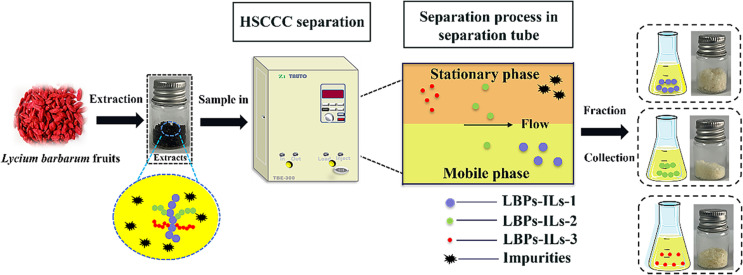Abstract
The traditional method for isolation and purification of polysaccharides is time-consuming. It often involves toxic solvents that destroy the function and structure of the polysaccharides, thus limiting in-depth research on the essential active ingredient of Lycium barbarum L. Therefore, in this study, high-speed countercurrent chroma-tography (HSCCC) and aqueous two-phase system (ATPS) were combined for the separation of crude poly-saccharides of Lycium barbarum L. (LBPs). Under the optimized HSCCC conditions of PEG1000-K2HPO4-KH2PO4- H2O (12:10:10:68, w/w), 1.0 g of LBPs-ILs was successfully divided into three fractions (126.0 mg of LBPs-ILs-1, 109.9 mg of LBPs-ILs-2, and 65.4 mg of LBPs-ILs-3). Moreover, ATPS was confirmed as an efficient alternative method of pigment removal for LBPs purification, with significantly better decolorization (97.1 %) than the traditional H2O2 method (88.5 %). Then, the different partitioning behavior of LBPs-ILs in the two-phase system of HSCCC was preliminarily explored, which may be related to the difference in monosaccharide composition of polysaccharides. LBPs-ILs-1 exhibited better hypoglycemic activities than LBPs-ILs-2 and LBPs-ILs-3 in vitro. Therefore, HSCCC, combined with aqueous two-phase system, was an efficient separation and purification method with great potential for separating and purifying active polysaccharides in biological samples.

Keywords Plus:STRUCTURAL-CHARACTERIZATION,PHYSICOCHEMICAL PROPERTIES,RHEOLOGICAL PROPERTIES,ASSISTED EXTRACTION,PURIFICATION,DERIVATIVES,WOLFBERRY,FRUITS
Published in INTERNATIONAL JOURNAL OF BIOLOGICAL MACROMOLECULES,Volume256,10.1016/j.ijbiomac.2023.128282;JAN 2024


